
Table of Contents
In a rush?
Download the PDF for later
FOREWORD
As more customer experiences have moved onto digital platforms, the expectations for companies to deliver a seamless and intuitive product experience are higher than ever. Gartner reported that by 2025, more than half of customers will resist using applications that deliver a poor user experience (UX). And this expectation applies to any industry and any business—users expect brands to use technology to shape their experience. To deliver on these expectations, companies are investing more in tech and product development. Investment in European tech firms reached a record high last year, soaring to $93.3 billion last year, or a 142% increase year over year.
While product teams have undergone immense pressure to adapt, build, and launch quickly, now the stakes are even higher to evaluate the digital experiences they’ve built and deliver more value to customers and the business. As a result, organisations are focused on optimising their product investments and seeking the data and technologies to help them make strategic decisions about their innovations.
In our 2022 State of Product Leadership report, we explore how product leaders are meeting these demands by focusing on data-driven approaches, drawing insights from both quantitative and qualitative sources, and switching to robust, business-based metrics to show value and impact.
SURVEY METHODOLOGY
In January-February 2022, we surveyed 350+ product managers and executives working largely for B2B software companies and traditional enterprises in France, Germany, and the United Kingdom. All respondents are partly or wholly responsible for digital product management within their organisations, from across a range of business sectors spanning both B2B and B2C.
We also looked at business performance across a range of product management metrics to identify a segment of leading companies from our group of respondents. Throughout the study, we compare the performance of leading companies against other respondents.
Below is a summary breakdown of the respondent profile:
Company type
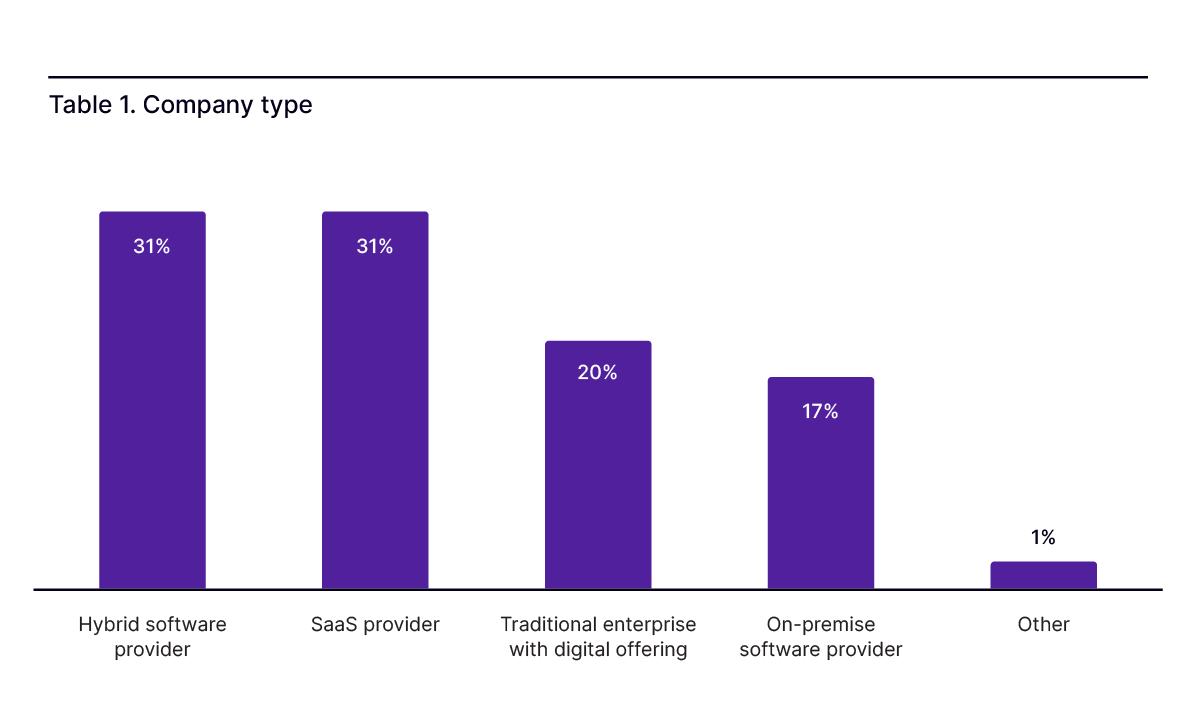
Company size
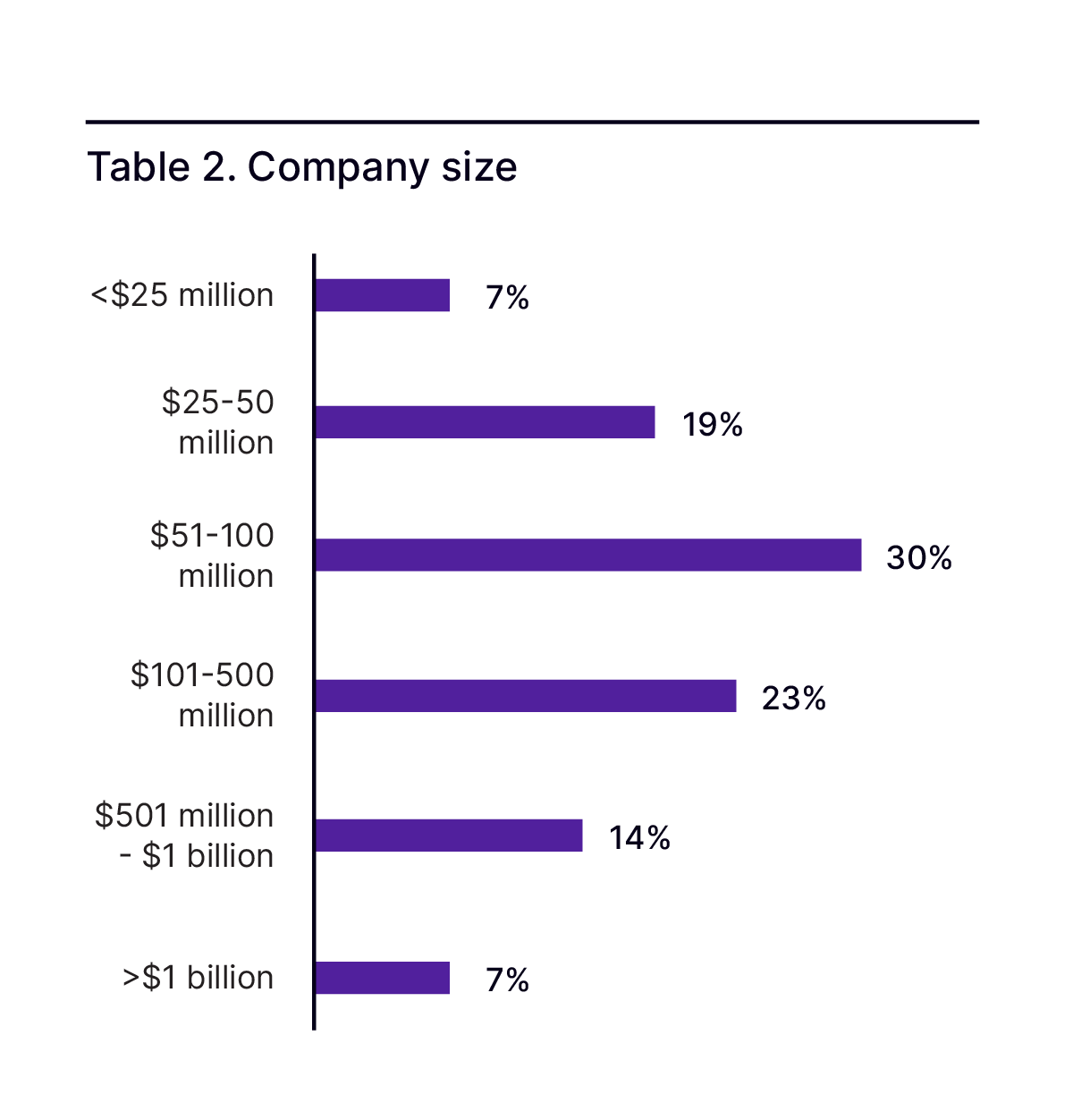
Levels
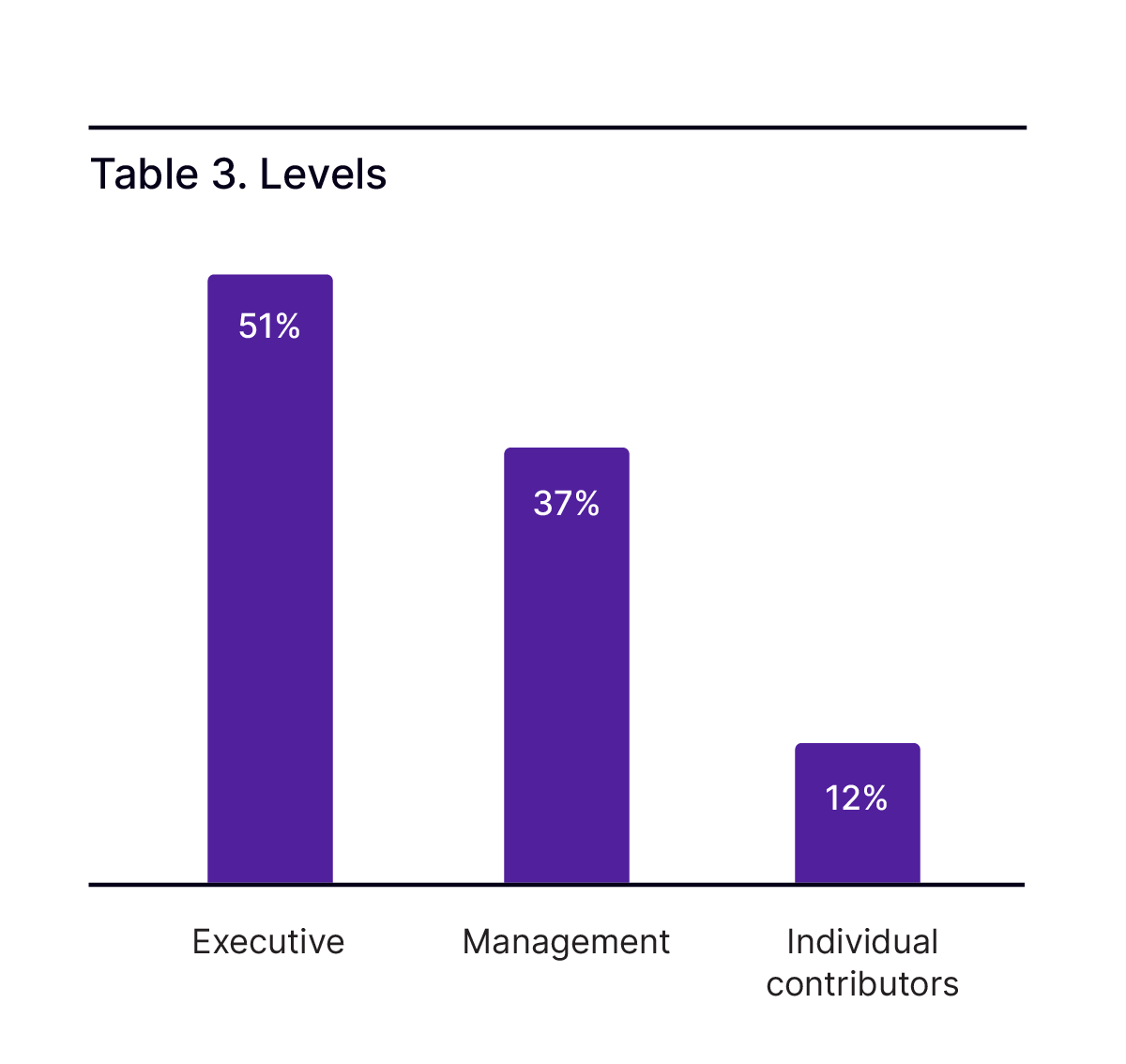
KEY INSIGHTS
1. Product management is growing as a strategic, influential business function
Product managers reported they are more focused on how customers experience their digital products. For example, 41% of survey respondents reported that “customer use of digital products and services” is the biggest factor shaping their approach to product management.
For their approach to succeed, respondents recognize the need to elevate the product management function throughout the business—31% of respondents reported that product development teams have greater influence in the organisation compared to previous years. Especially within product-led organisations, there’s more pressure on and inclusion of product management teams to help shape and influence how products impact the customer.
Table 4. Trends shaping product management approaches
To what extent do you think the following trends will shape how your organisation approaches product management through 2022 and beyond?
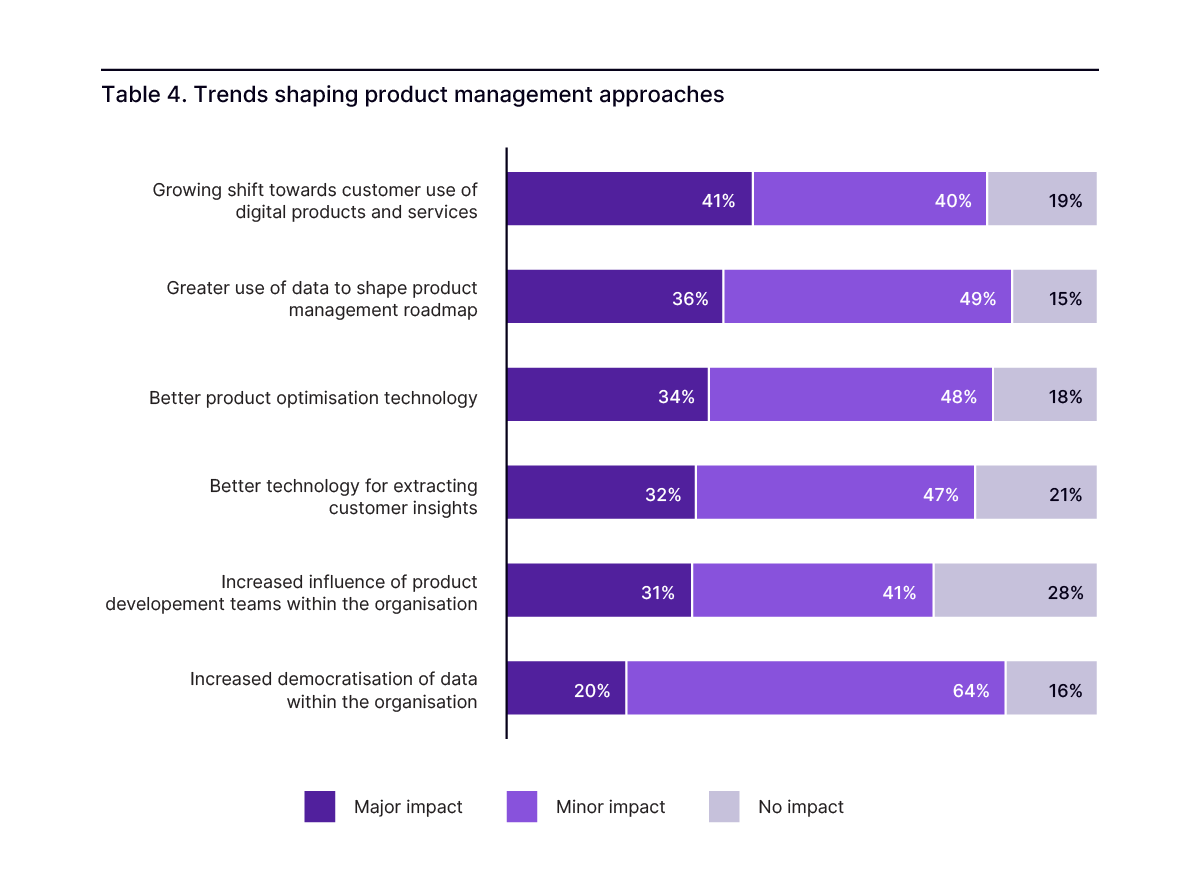
The growing influence of product management is also evident in the growing areas of responsibilities that respondents reported. Our survey found that product teams’ work is spilling into more cross-functional areas. For example, product management involvement in customer onboarding and customer education/training increased by 14 and 13 percentage points in the last year, respectively.
As the influence of product development continues to grow outside of the product organisation, leaders will be pressed to operationalize decision making and knowledge sharing to drive alignment and consistency.
Table 5. Product management responsibilities
How would you describe your responsibility with respect to the following functions?
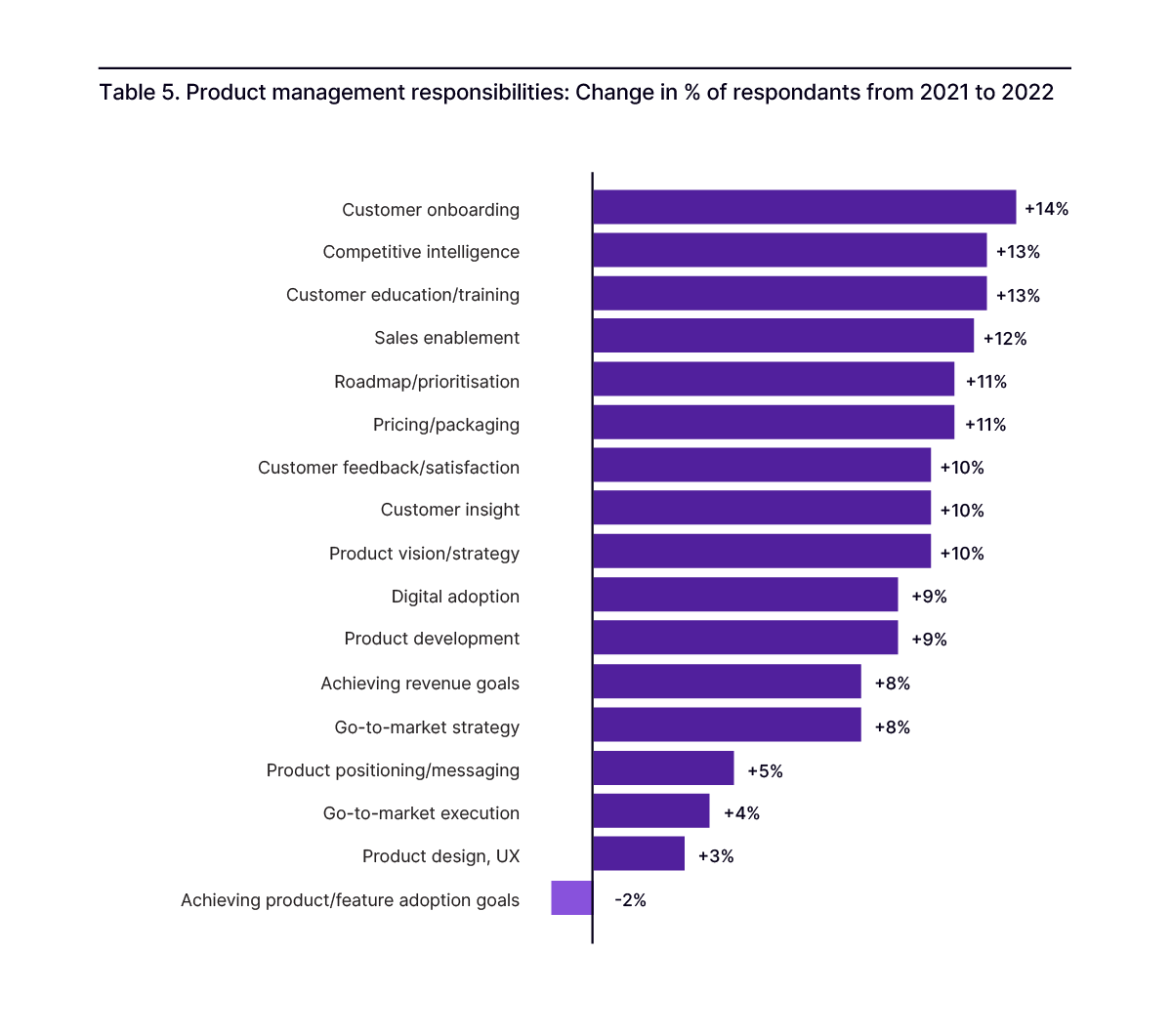
2. For leading companies, product management has become a driver of digital transformation initiatives
Last year we reported that product management teams are at the forefront of digital transformation in Europe, likely due to their visionary and multidimensional thinking capabilities. This year we compared digital transformation responsibility for leading companies against their peers and found that product development teams at leading organisations are almost 2X more likely to be responsible for the company’s digital transformation efforts than those at mainstream competitors (61% for leading companies vs. 35% for mainstream).
Within these leading organisations, responsibility for digital transformation is also more likely to be spread across different business functions. The product management department plays an important role in digital transformation efforts, partnering with sales/marketing and the executive team. Within mainstream companies, product management is significantly less involved in digital transformation than other functions.
Table 6. Digital transformation responsibility
Which departments are perceived to be responsible for digital transformation at your company?
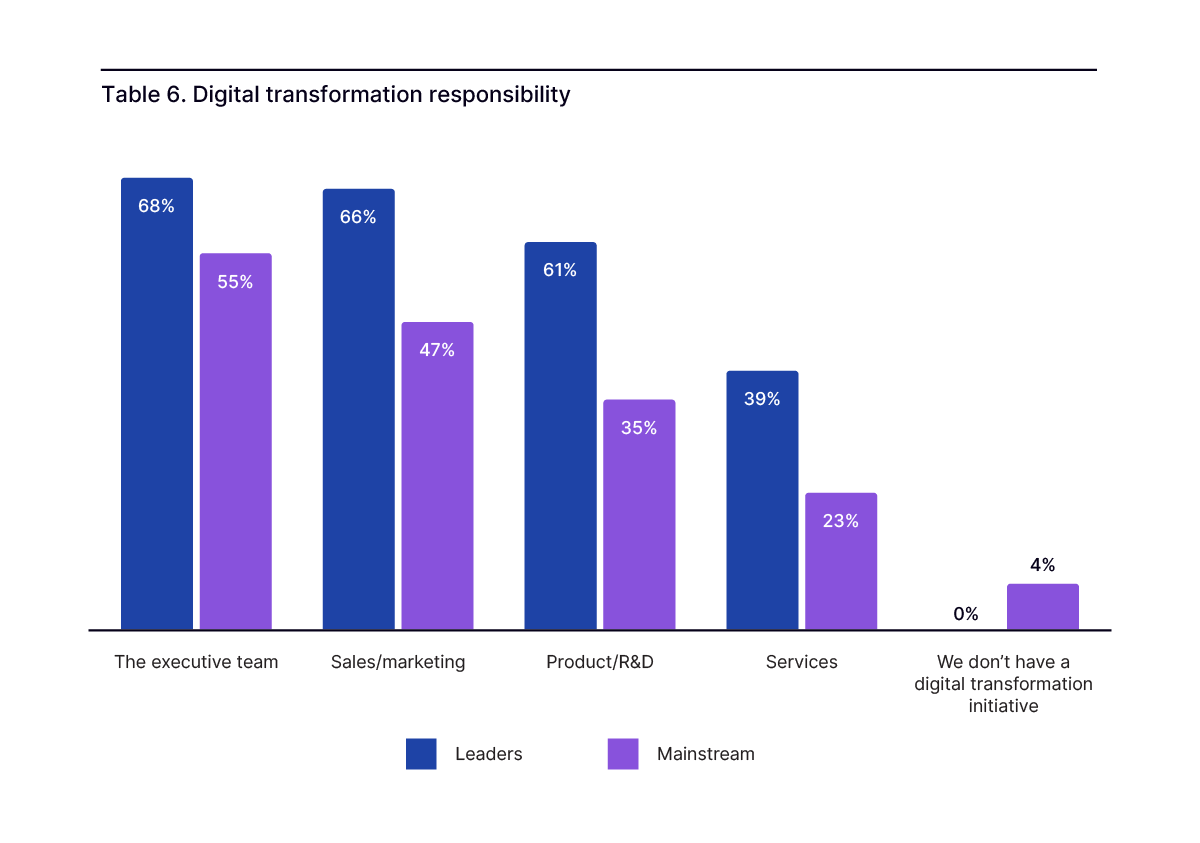
3. Product leaders prioritize quality and impact of products over quantity of releases
Historically, product leadership has been valued and measured by adherence to the product roadmap and the number of features and products launched. Last year, for example, delivery against the product roadmap was the single most important metric of product management success. It was seen as a primary metric by two-thirds (67%) of respondents, compared to less than half who said the same for revenue (45%), product usage (40%), or product adoption (38%).
Today, product management success is more likely to be judged on revenue. In our 2022 survey, 56% of respondents reported that revenue and product usage are the most important metrics, followed by product/feature/roadmap delivery. This finding further suggests that companies are becoming more focused on optimizing and driving adoption of the products they’ve already launched, rather than introducing new ones.
Table 7. Success metrics
What are the most important methods for measuring product management success?
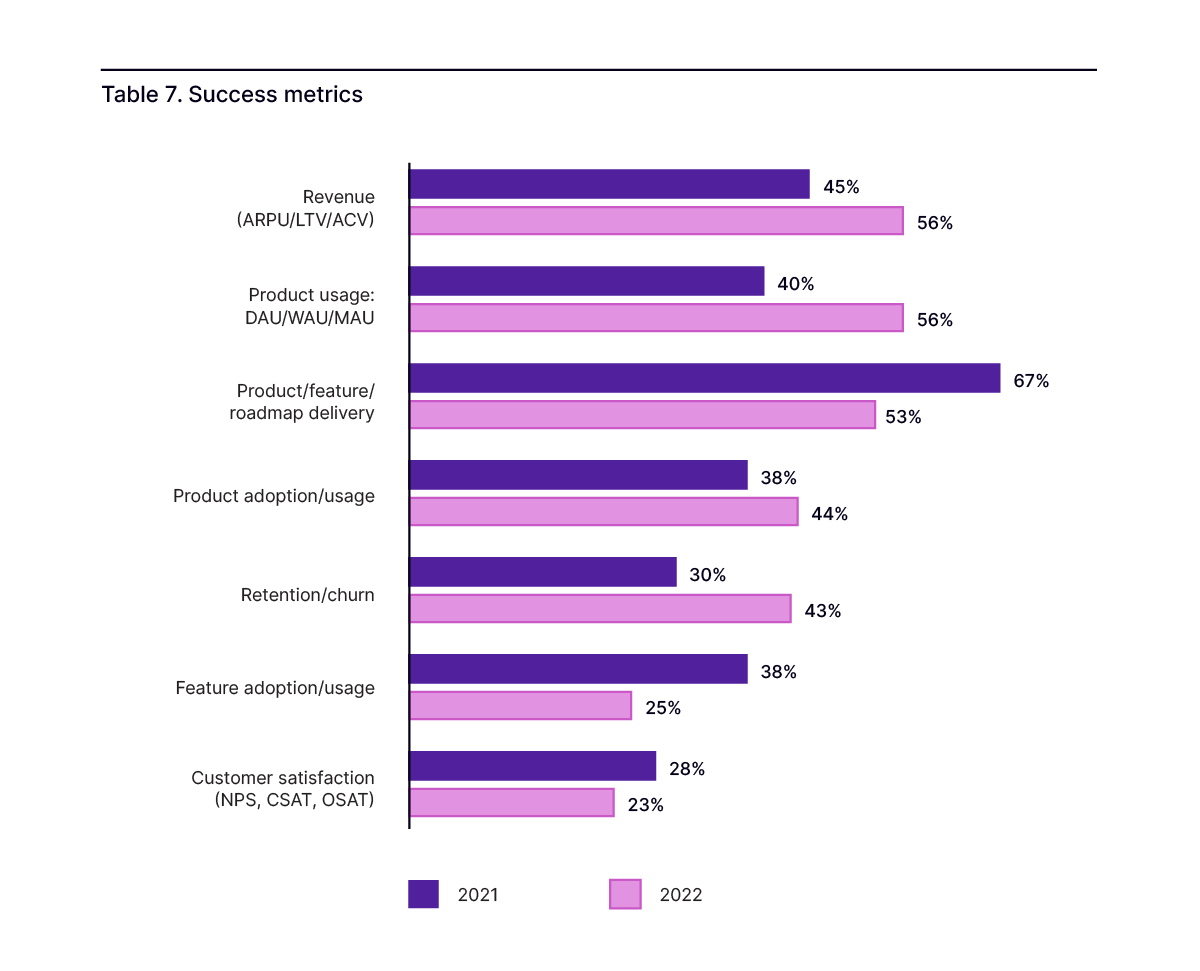
4. Data is driving more decision making, especially for leading companies
As the previous finding indicated, the stakes for product leadership to build products that drive the business forward are even higher. This means it’s become more important for product development teams to be able to measure and optimise product usage and engagement.
To address this, more product management organisations are using data-driven insights to inform product decisions. Our 2022 survey found that more product management organisations are using data to make product roadmapping decisions, with the percentage of data-driven companies using quantitative insights doubling, from 37% in 2021 to 71% in 2022.
Table 8. How roadmap decisions are made
2021 vs. 2022
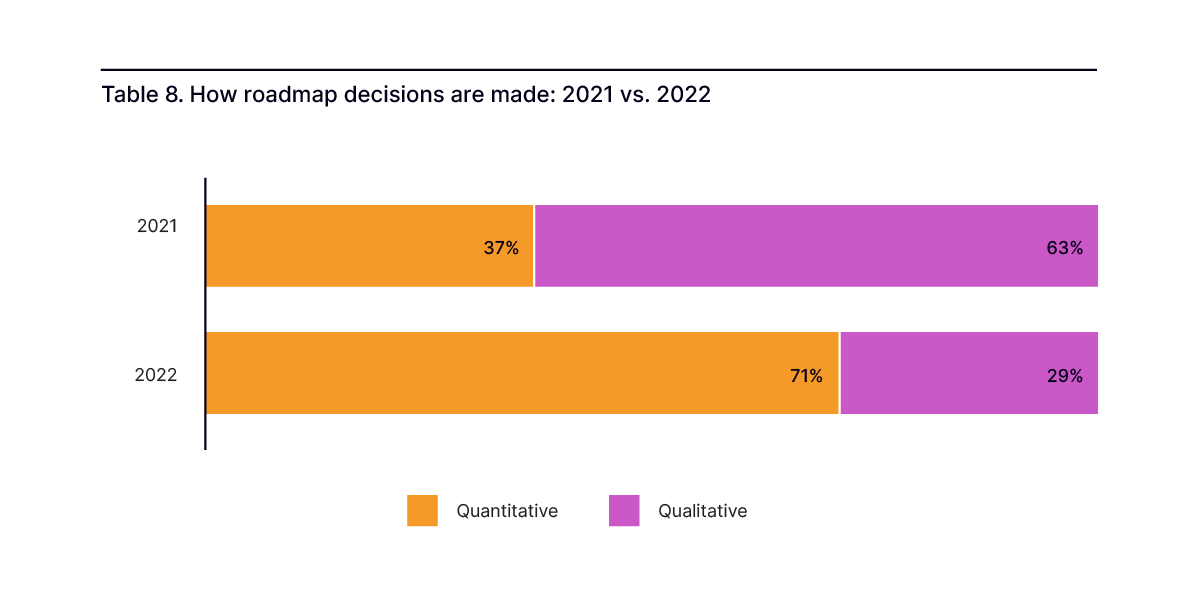
Those who have invested in becoming more data driven are making a bigger impact. According to our 2022 study, leading companies are 6X more likely than mainstream organisations to lead with data in their decision making. What’s more, these companies are 34% more likely to base product decisions only on quantitative data.
However, there is also a significant group of leaders (32%) that continue to be mainly or fully instinct driven. These findings indicate there’s value in both quantitative and qualitative data. While qualitative instincts and customer feedback are valuable for digging deeper into trends and identifying new opportunities, quantitative data is essential for getting teams and departments around a shared foundation for measurement, driving adoption, and growth—metrics that are critical to a business’s health.
While data is becoming more integral to the product development function, it doesn’t replace the collaboration, ideation, and creativity that are essential to the job. Rather, both quantitative and qualitative data feed group decision making and collaboration. Brainstorming discussions and collaboration are smoother, more efficient and more effective when you have the data you need to inform them.
Table 9. How roadmap decisions are made
Quantitative vs. qualitative
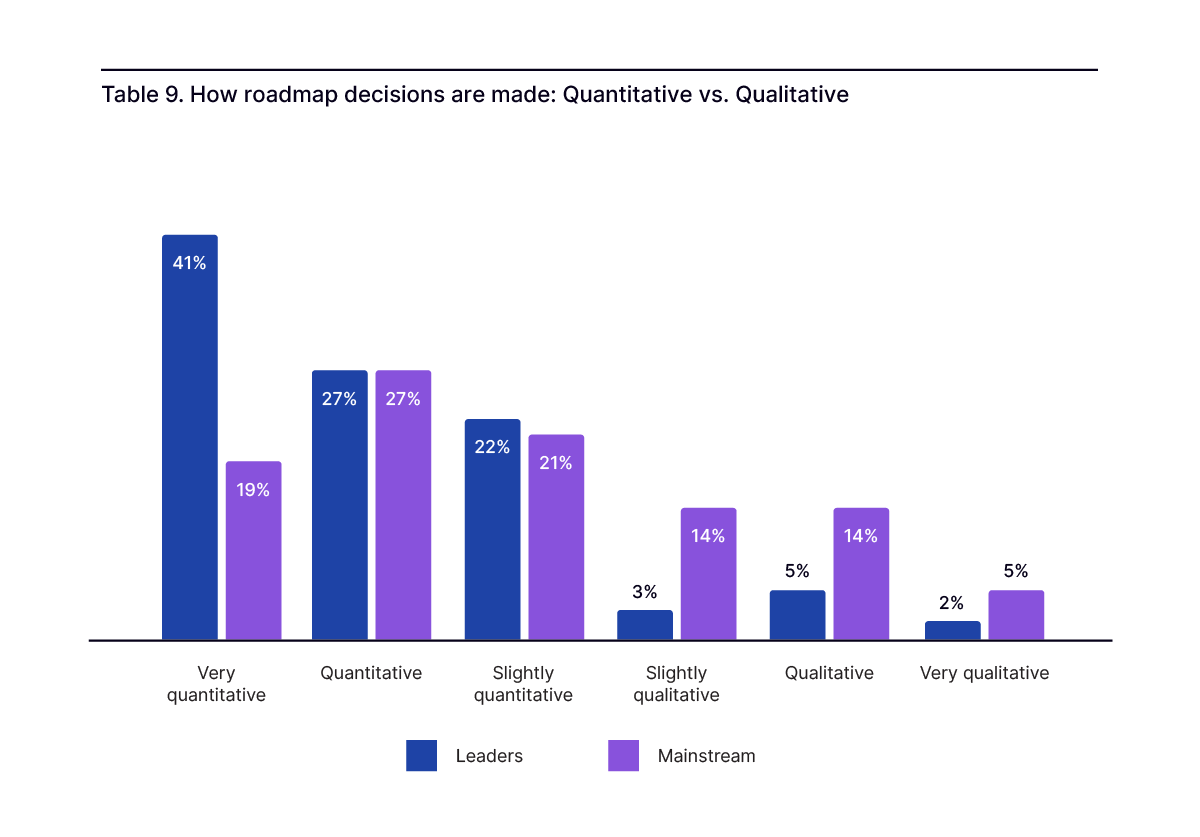
Table 10. How roadmap decisions are made
Data vs. instinct
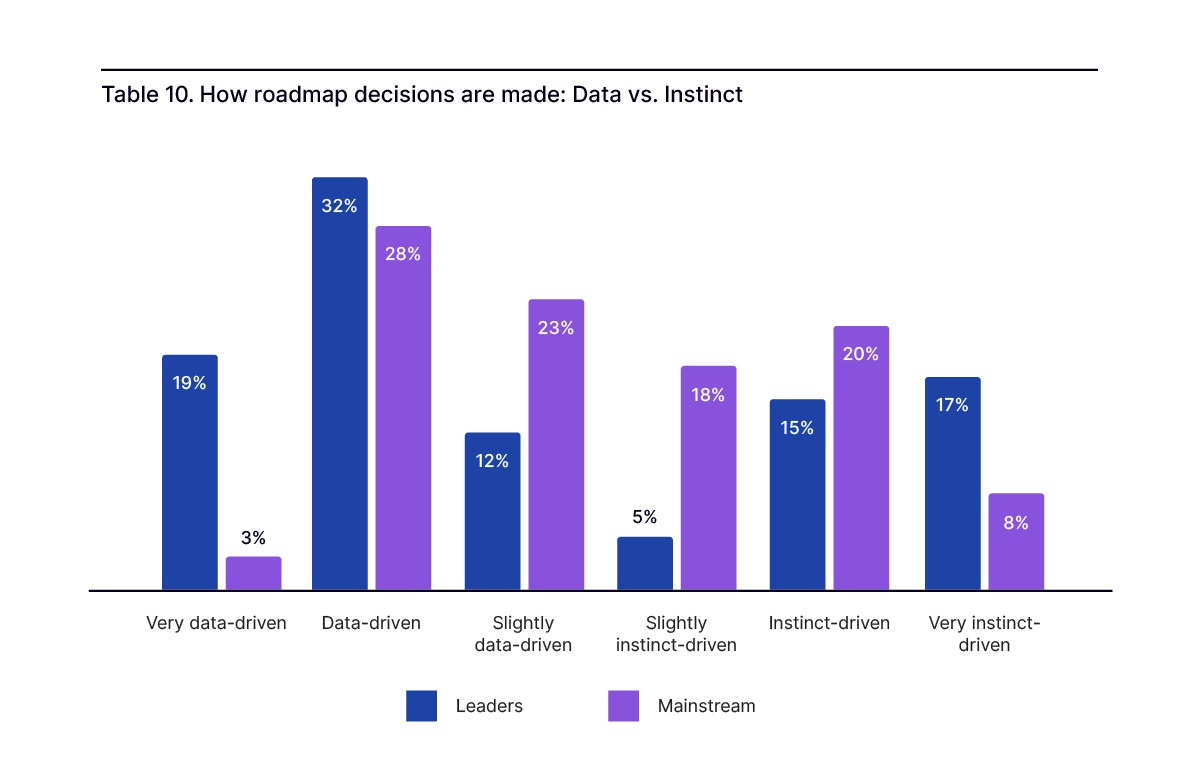
5. Investment in the product tech stack is growing
The smartest product organisations understand that to deliver the best software experiences, you have to understand exactly what’s happening inside the product: where users are struggling, where they succeed, and which features are being used the most. They’re also aware that customer expectations are changing fast, and that simply delivering against a roadmap is no longer enough. Our research found that leading companies are more likely to draw on insights from a variety of data and analytics sources, including usage/product analytics, CSAT surveys, competitor market intelligence, and real-time user feedback.
While product leaders understand that the right analytics are needed to deliver actionable insights, they report they lack the technology needed to collect and analyze product data—with 33% of respondents reporting that lacking the right tools is a barrier to data-driven product development.
Table 11. Barriers to success
To what extent do you regard the following as barriers to data-driven product development?
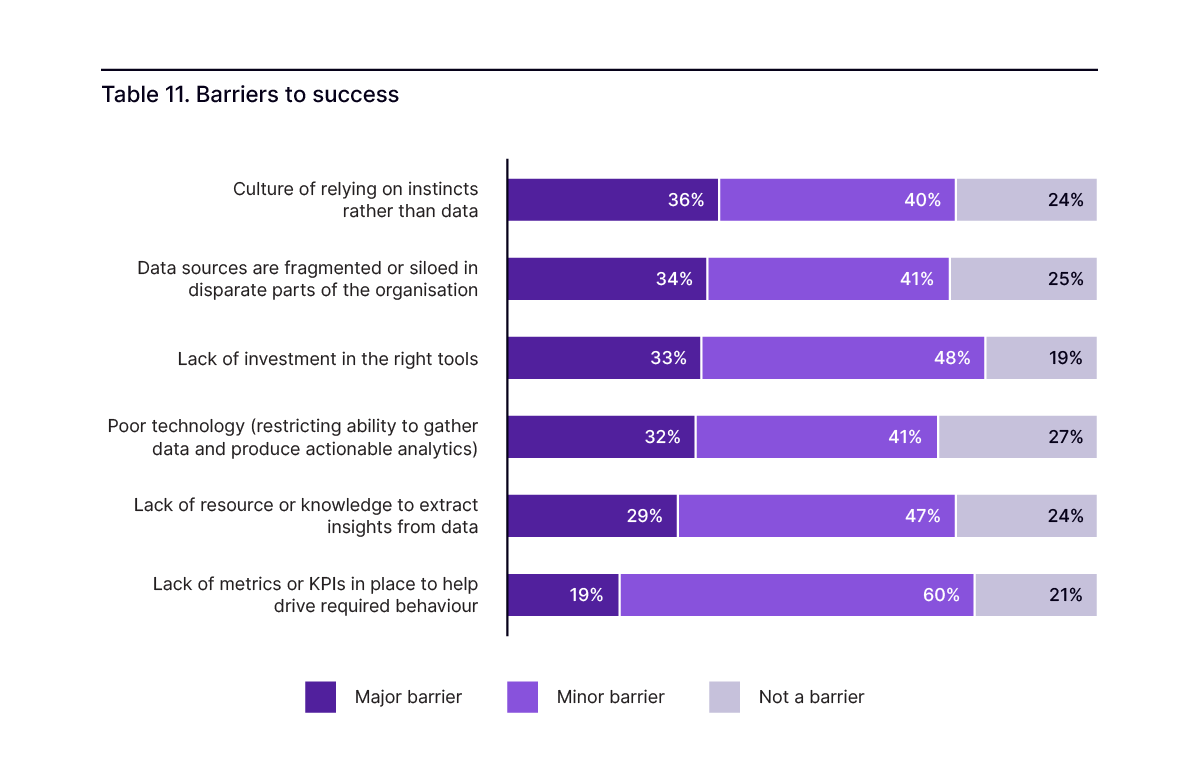
To help teams meet demand and expectations, respondents report their organisations are investing more in product management technology. Our survey found that 52% of respondents said their organisation planned to increase its investment in product management technology in 2022, compared to 45% which expected to keep investment the same.
With the investment in and integration of more tools, organisations will need to be mindful about how these tools support the broader product tech stack. Whether you’re investing in a comprehensive platform or integrating bespoke tools into an existing stack, it’s crucial to operationalize how new investments will intersect across product-facing teams.
Table 12. Technology investments
How would you describe your organisation’s likely investment in product management technology in 2022?
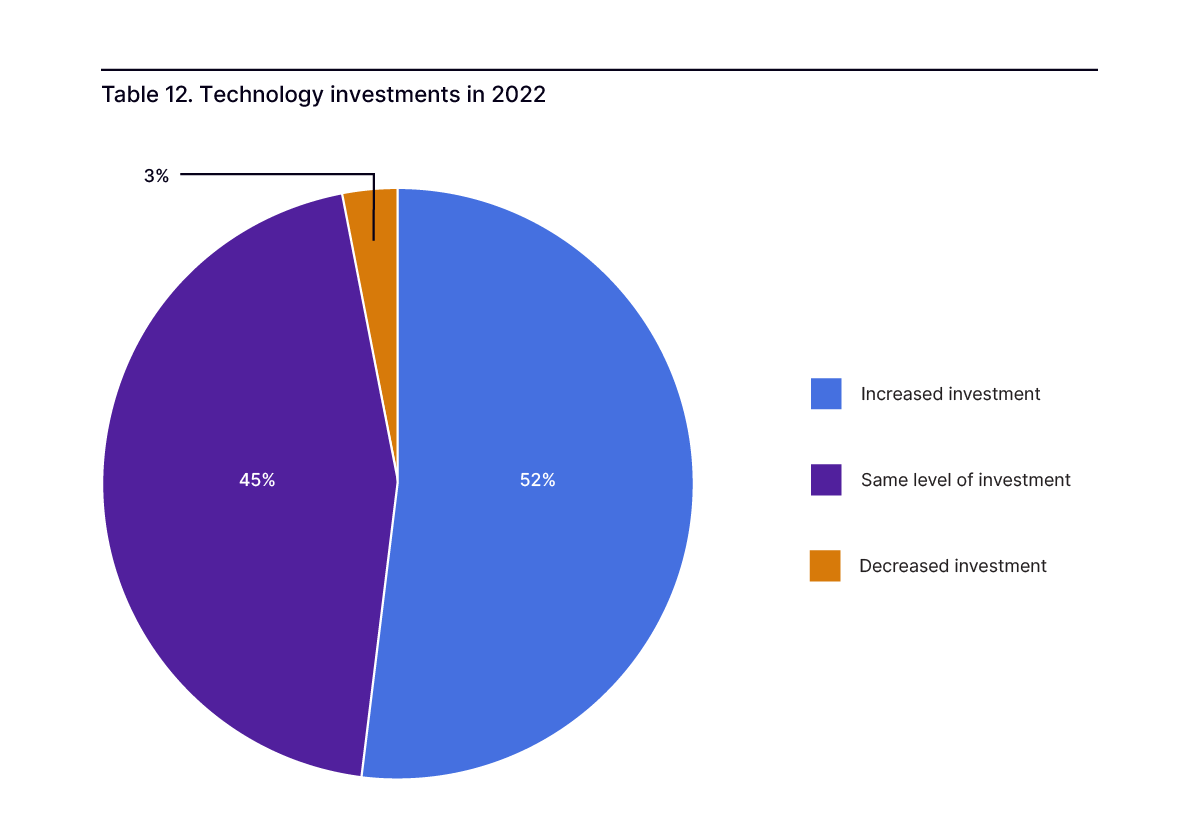
6. More data and more tools can lead to more complexity
As product teams become more data driven, they experience challenges that hinder their ability to use data efficiently and effectively. Survey respondents report the leading barrier to effective product management is lack of process, followed by failure to leverage data and poor technology. To help product management and development teams efficiently leverage the data and technology at their disposal, we see companies employing a new product function focused on operations, known as “product operations” or “product ops.”
The more strategic and influential the product development organisation becomes throughout the business, the more they will need support to streamline and operationalize their work. Product operations teams are responsible for helping product management make more reliable decisions by equipping them with relevant product data. Product ops also works to make product data more accessible throughout the business, enabling more teams within and outside product development to leverage product data in decision making.
Table 13. Challenges for product management
What do you regard as your organisation’s greatest challenge in the context of effective product management?
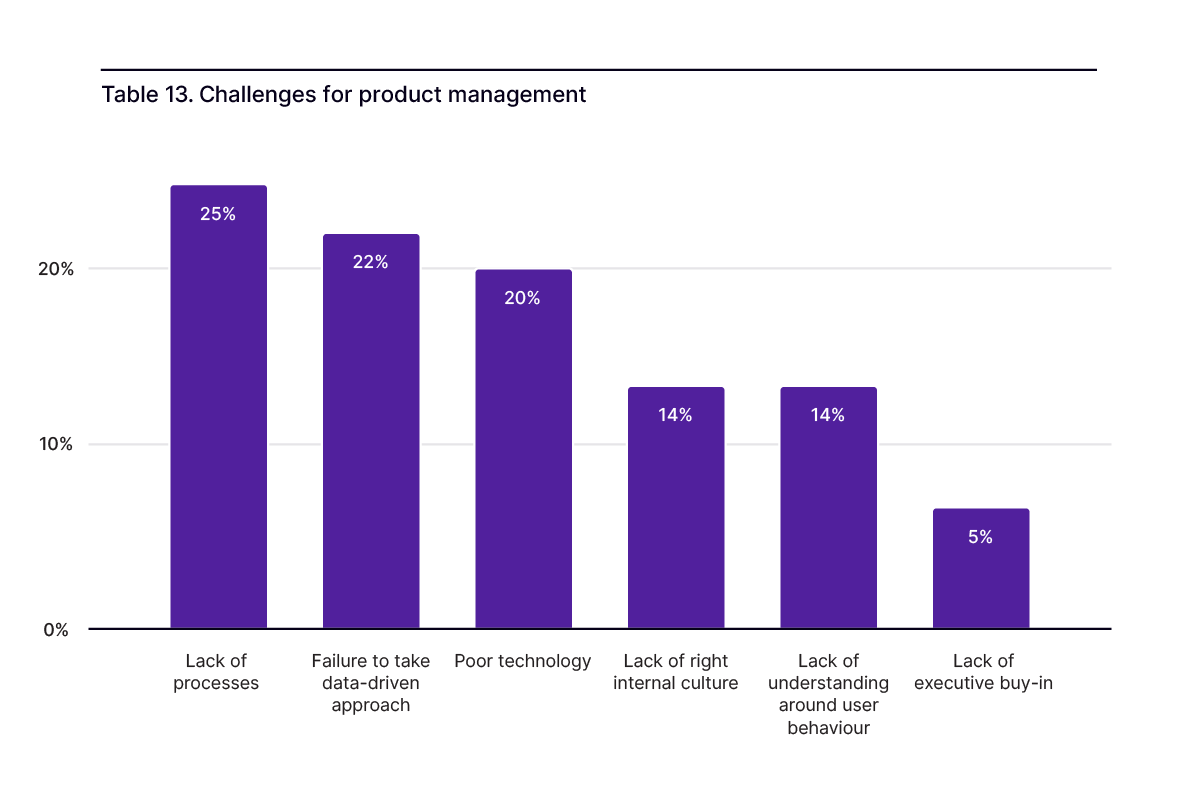
RECOMMENDATIONS
This year’s report suggests that in a world with escalating expectations, the most successful companies are leveraging their influence and changing the way they develop and optimise products. As a result, product leaders and their teams are becoming increasingly important to their businesses. They are working to integrate the product into more departments across the business and put product data at the center of their decision-making approach.
All the trends identified in this report are driving product management toward a more central and strategic role. Product leaders who lean into this shift will be well-equipped to elevate their products, their businesses, and the product management field in 2022 and beyond.
Below are three strategies organisations can employ to elevate the influence and impact of product leadership:
1. Define your product analytics strategy
Our survey found that product management teams have become more data driven over the last year. More product managers are seeking out metrics that will help them understand how users navigate their product, how product usage correlates with positive outcomes, and how their product impacts the business’ bottom line. But just because you’re tracking product metrics doesn’t mean you’re tracking the right product metrics.
While more product leaders are putting data at the center of nearly everything they do, effective decision making requires product teams to align on which product metrics matter most. The right KPIs for any one company to track will ultimately depend on its product, growth stage, and overall goals.
2. Streamline tools to reduce complexity and improve collaboration
Product management teams report they lack the tools to get the insights they need to make data-driven decisions. The growing investment in product management technology is a positive indicator that organisations are committed to enabling product teams with the right tools to help them succeed.
As product leaders evaluate their investment opportunities, they will need to consider how new solutions may support, elevate, or hinder their tech stack. Oftentimes product teams rely on a variety of point solutions to support different areas of their strategy and operations. However, this usually leads to having to work with a complex, patched-together tech stack. organisations can simplify and improve operations by considering an all-in-one solution that offers a broader suite of tools to support key product management activities.
3. Empower more teams to leverage product insights
As the influence of product management continues to expand into other areas of the business, product leaders have an opportunity to scale how teams outside of product (across marketing, sales, customer success, and others) leverage the product and product data to propel the business forward. With effective measurement in place, teams can base decisions on a shared set of data, and deliver customer experiences that both meet and exceed expectations at every stage.